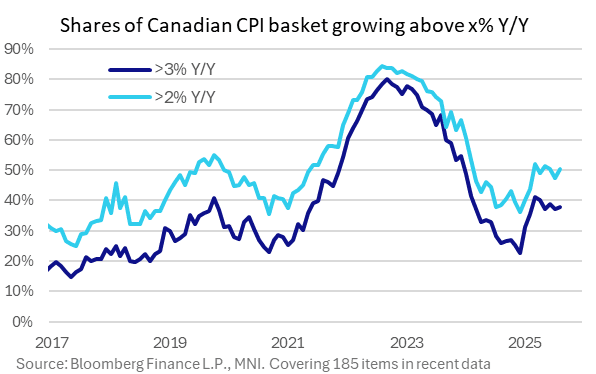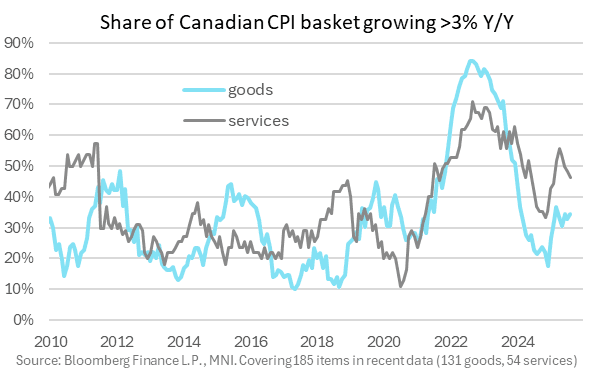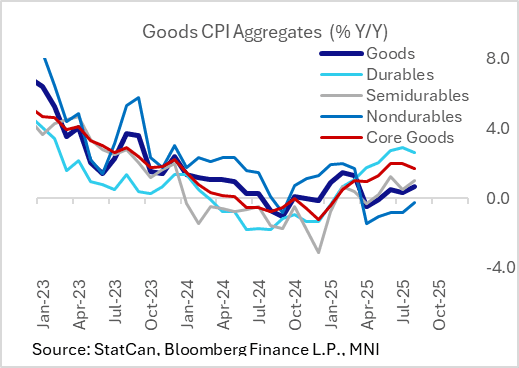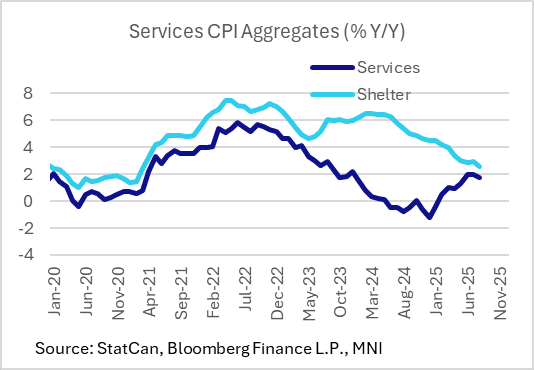EM LATAM CREDIT: LATAM Credit Market Wrap
Source: Bloomberg Finance L.P. Measure Level DoD 5yr UST 3.55% -7bp 10yr UST 3.97% -5bp 5s-10s UST...
Want to read more?
Find more articles and bullets on these widgets:
Historical bullets
CANADA: Services Inflation Breadth Showing Signs Of Moderating
Dispersion measures showed a mixed picture of inflationary pressures in August.
- The share of all items (185 tracked by MNI) seeing faster than 2% inflation picked up to 50.3%, returning to June's level after a dip to a 5-month low 47.6% in July.
- The proportion above 3% was basically steady (37.8% after 37.3%) but the 4+% category narrowed to 29.2% of the basket after 30.3% in each of the prior 5 months.
- Breaking out goods vs services:
- Items rising above 2% picked up for goods to 32.4% from 30.3% prior for a fresh 5-month high (which looks energy-related), with that for services only up mildly at 17.8% vs 17.3% prior.
- Above 3% and the divergence was more stark: goods in that bracket rose to 34.4% (32.8% prior), but for services the proportion fell to a 6-month low 46.3%, the 4th consecutive sizeable decline.
- And above 4%, 18.9% of goods were in that category, unchanged for the last 3 months - but for services, the proportion fell to 10.3%, the lowest since February.


CANADA: Underlying CPI Details Include Softer Core Goods Theme
While the broader trend of softening in the major core CPI metrics were reinforced in August's inflation report, the category-by-category details also will have added some encouragement for the BOC that price pressures are at worst steadying out and potentially set to moderate.
Goods: Goods price inflation continued to pick up: August marked a 5-month high 0.7% Y/Y (0.3% prior), however core goods pressures dipped for the first time since April, at 1.7% Y/Y after 2 months at 2.0%.
- Durable goods inflation - which had been seen as a warning sign for trade war-related price pressures - faded. Most notably, vehicle and household furniture prices saw less upside pressure than in previous months.
- And as the headline/core divergence suggests, it was food (3.4% after 3.3%) and energy (-8.3% after -10.4% for the "highest" since March, before the consumer carbon tax reprieve) that helped fuel at least part of the pickup. Ex-energy inflation fell to 2.6%, a 4-month low, after 2.7% the two prior months.
- As such, nondurables goods inflation picked up to -0.3% Y/Y after -0.8% for a 5-month high.
- Semi-durables inflation picked up as well to 1.0%, from 0.5% prior. This category - which includes household textiles, kitchen utensils, clothing, footwear, jewellery, fabrics, photographic equipment, and toys and games - includes clothing which saw a pickup in Y/Y inflation to 2.1% from -0.3%, highest in 50 months.
Services: Services prices inflation was flat at 2.8% Y/Y, a joint 6-month low.
- Importantly, shelter prices resumed their descent after July's surprise tick higher (2.6% after 3.0%, a fresh 52-month low), as rented accommodation inflation more than reversed July's jump to 5.0%. Owned accommodation inflation fell to 2.3% from 2.5%, a 54-month low, as mortgage interest and replacement costs continued to disinflate.
- Non-shelter services ticked higher though despite a decline in travel services, with household communications and personal care services contributing to upside.


US OUTLOOK/OPINION: Macro Since Last FOMC - Prices: But Somewhat Contained [2/2]
- That being said, latest readthrough to core PCE inflation paints a less hawkish picture. With August CPI and PPI inputs to hand, analyst unrounded estimates appear to be centered around core PCE inflation of 0.20% M/M, or at least a median around there with a risk of being a little higher.
- If accurate, that would follow 0.27% M/M in July and 0.26% M/M in June, implying some moderation after a string of more clearly above-target prints. Assuming no revisions, it would see year-ago core PCE inflation of 2.9% Y/Y (vs 2.7% in January at the start of the Trump administration) and with a three-month rate only modestly higher at 3.0% annualized.
- The median FOMC forecast from June eyed an average 3.1% Y/Y for 4Q25.
- For broader context, monthly tariff revenues were worth circa 1.8% of overall personal consumption expenditure after a 1.3pp increase under the Trump administration. This only gives a sense of aggregate potential adjustment, with the burden split across importers, businesses and consumers. This aggregate impact has room to increase further judging by actual tariff revenue as a share of imports compared to effective tariff rates.
